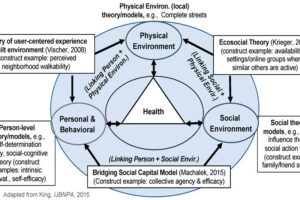
6. (c) Discuss the targets of focused interventions of the Jal Shakti Abhiyan: Catch the Rain, 2024 in rural and urban areas. 15 Marks (PYQ/2024)
Answer:
The Jal Shakti Abhiyan: Catch the Rain 2024 campaign aims to enhance water conservation across India with the theme “Nari Shakti se Jal Shakti”, emphasizing women’s role in sustainable water management. Implemented from March to November 2024, it focuses on rainwater harvesting, rejuvenation of water bodies, afforestation, groundwater recharge, and awareness generation in both rural and urban areas.
Models

Integrated Water Management Models
- GIS-Based Locational Analysis: This model uses Geographic Information Systems (GIS) to map rainfall patterns, water bodies, and catchment areas. It supports the identification of drought-prone zones and areas needing intervention, both in rural and urban settings. Key Insight: Detailed spatial mapping helps in precise geo-tagging and the creation of science-based water management plans. Source: Ministry of Jal Shakti; IMD Reports.
- Water Budget and Catchment Models: Such models quantify the balance between water inputs (rainfall) and water losses. They are essential for designing structures that improve groundwater recharge and rainwater harvesting efficiency. Key Insight: By analyzing water availability and deficits, planners can strategize interventions to capture and store rainwater effectively.
Theories
Diffusion and Sustainability Theories
- Diffusion of Innovations (Everett Rogers): Rogers’ theory explains how innovations—like modern rainwater harvesting techniques and de-silting methods—spread through communities. In this campaign, the focus is on accelerating adoption across all districts. Key Insight: Emphasis on relative advantage and observability accelerates the spread of best practices in both rural and urban sectors.
- Sustainable Development Theory (Brundtland Commission): This theory advocates development that meets current needs without compromising the future. In water management, it underlines the need for long-term measures that enhance water security and ecosystem sustainability. Key Insight: Sustainable interventions now will yield persistent benefits, making communities resilient to future water challenges.
Laws
Legal and Policy Frameworks
- National Water Policy (2012): This policy steers water conservation efforts and ensures the efficient and equitable use of water resources. It supports interventions such as artificial recharge and rainwater harvesting. Source: Ministry of Jal Shakti, Government of India.
- Environment (Protection) Act, 1986: Provides the regulatory framework to manage water bodies, prevent encroachment, and support sustainable water management practices.
- Jal Shakti Abhiyan Operational Guidelines: These guidelines detail the specific targets and monitoring protocols for interventions across rural and urban areas, ensuring transparency and effective implementation. Source: Press Information Bureau (PIB), Ministry of Jal Shakti.
Perspectives
Integrated Socio-Economic and Gender Perspectives
- Political Economy Perspective (Immanuel Wallerstein): This lens examines how governmental policies, market forces, and community participation interact. The emphasis on Nari Shakti reinforces the crucial role of women in local water management and community mobilization. Key Insight: Empowering women in water conservation leads to enhanced implementation and sustained local commitment.
- Sustainable Development Perspective: Emphasizes balancing environmental protection, economic growth, and social inclusion. Interventions must improve access to safe water while preserving ecosystems through afforestation and de-silting initiatives.
Case Studies
Case Study 1: Rural Intervention in Marathwada, Maharashtra
- Overview: The Marathwada region has historically faced chronic water scarcity. Interventions under earlier Jal Shakti campaigns, including rainwater harvesting and check-dam construction, have improved groundwater levels by approximately 15–20%.
- Data & Impact: A NITI Aayog report (2023) observed significant improvements in agricultural productivity and rural incomes, thanks to increased water availability. Source: NITI Aayog Reports; Economic Survey of India (2023).
Case Study 2: Urban Intervention in Chennai, Tamil Nadu
- Overview: After the severe water crisis of 2019, Chennai has implemented targeted urban water conservation measures—such as the revitalization of neglected water bodies and drainage channel desilting—to enhance municipal water supply.
- Data & Impact: Recent urban water management initiatives have resulted in a 20% increase in groundwater recharge and a 25% reduction in non-revenue water. Source: Central Water Commission (CWC); PIB Press Releases (2023).
Conclusion
The Jal Shakti Abhiyan: Catch the Rain, 2024 campaign is designed to implement area-specific interventions in both rural and urban areas. By leveraging integrated water management models, applying theories from Diffusion of Innovations to Sustainable Development, and backing these measures with robust legal frameworks and inclusive perspectives, the campaign strives to enhance water conservation, improve groundwater recharge, and empower communities—especially through women’s participation. The successes observed in Marathwada and Chennai provide a compelling blueprint for scaling these interventions nationwide.
Tag:Geography Case Study, Geography Optional, geography optional case study, Geography Optional Pyq, geography optional pyq 2024, groundwater recharge, human geography, Jak Shakti Abhiyan: Catch the rain, JalShakti Abhiyan, models theories laws and perspective in geography, rainwater harvesting, Water conservation


